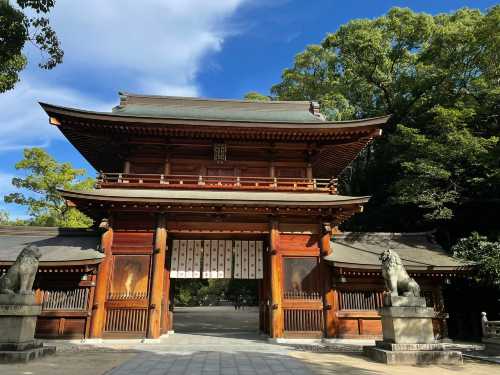Popular Trip Moments
Imabari Castle🏯 | Japan's cherry blossom viewing spot - Kaizan Park on Hakata Island in Imabari City, Ehime Prefecture, with 1,000 cherry trees and the Seto Inland Sea, a must-see view in your lifetime! | "From prosperity to decline, a city striving for transformation" - Imabari City (Shikoku, Japan) | [Ehime/Imabari] When you think of Ehime, you think of Imabari towels! *Towel Museum* | [Ehime/Imabari] A spectacular spot! Panorama Observatory Bridge *Kirosan Observatory* | 🇯🇵 [Ehime Prefecture] A simple art museum! Omishima Museum of Art (^ ^) | 🇯🇵 [Ehime Prefecture] A beautiful scenic spot! Kurushima Kaikyo SA! (^^) | 🇯🇵【Ehime Prefecture】You can eat rare luxury fish! Tatara Shimanami Park(^^) | 🇯🇵 [Ehime Prefecture] A 2600-year-old cedar tree! A power spot! Oyamazumi Shrine (^^) | 🇯🇵 [Ehime Prefecture] Pray for recovery from illness and eradication of epidemics! Gion Shrine⛩️ | 🇯🇵 [Ehime Prefecture] Jippoji Temple has a long history! (^^) | 🇯🇵 [Ehime Prefecture] One of the New Shikoku Mandala Sacred Sites! "Bekku Oyamazumi Shrine" (^^) | 🇯🇵 [Ehime Prefecture] 59th temple of the 88 Shikoku Pilgrimage, Konkozan Saishoin Kokubunji | 🇯🇵 [Ehime Prefecture] Shikoku 88 Temple Pilgrimage, 58th Temple, Sakureizan Senkoin, Senyuji Temple | 🇯🇵 [Ehime Prefecture] 57th temple of the 88 Sacred Places of Shikoku, Mt. Futo, Muryojuin, Eifukuji | 🇯🇵 [Ehime Prefecture] 56th temple of the 88 Sacred Places of Shikoku, Kanawasan, Chokoin, Taisanji | 🇯🇵[Ehime Prefecture] 55th temple of the 88 Shikoku Pilgrimage, Bekkuyama Kongoin Nankobo | 🇯🇵 [Ehime Prefecture] 54th temple of the 88 sacred places of Shikoku, Chikamisan, Hoshoin, Enmeiji | [Ehime, Imabari] Imabari Castle 🏯 | [Ehime] Observatory where you can enjoy a spectacular 360-degree panoramic view | A museum where landscape and architecture come together | A restaurant where you can enjoy authentic Neapolitan pizza | 🇯🇵【Ehime Prefecture】When you come to Ehime Prefecture, take a break at the roadside station "Imabari Yunoura Onsen" (^^) | Strawberry Picking in the Air | ■ The day when we felt spring early | ■ Osumi Seaside Park | Seto Inland Sea Bike Tour | 🇯🇵 [Ehime Prefecture] Imabari Castle is popular for its fantastic lighting! 🏯^ ^ | [A cafe in Imabari City surrounded by a cool breeze] | 🇯🇵 [Ehime Prefecture] Roadside Station Oshima! Lots of specialty product corners! (^^)
Popular Travel Types
Popular Destinations
Sharm El Sheikh Travel | Ipswich Travel | Florence Travel | Split Travel | Stoke-on-Trent Travel | Philippines Travel | Kuala Lumpur Travel | Lahore Travel | Naples Travel | Changsha Travel | Copenhagen Travel | Switzerland Travel | Stockholm Travel | Guangzhou Travel | Singapore Travel | Motherwell Travel | Lincolnshire Travel | Tamworth Travel | Helsinki Travel | St Julian's Travel | Benton County Travel | Batticaloa Travel | Foshan Travel | Preston County Travel | Bocas del Toro Travel | Muscatine Travel | Anhua Travel | Honghe Travel | Forster Travel | Bacoor Travel
Recommended Attractions at Popular Destinations
Bangkok attraction near me | Manila attraction near me | Tokyo attraction near me | Taipei attraction near me | Hong Kong attraction near me | Seoul attraction near me | Kuala Lumpur attraction near me | Los Angeles attraction near me | Shanghai attraction near me | New York attraction near me | Shenzhen attraction near me | Osaka attraction near me | Singapore attraction near me | London attraction near me | Guangzhou attraction near me | San Francisco attraction near me | Beijing attraction near me | Macau attraction near me | Bali attraction near me | Jakarta attraction near me | Paris attraction near me | Ho Chi Minh City attraction near me | Istanbul attraction near me | Phuket attraction near me | Chicago attraction near me | Seattle attraction near me | Toronto attraction near me | Orlando attraction near me | Cebu attraction near me | Chiang Mai attraction near me
Popular Attractions
Santa Maria delle Grazie | Aquaria KLCC | Santiago Bernabéu Stadium | Universal Studios Japan | S.E.A. Aquarium | Yu Garden | Musee de l'Orangerie | Battersea Power Station London: Lift 109 | Langkawi SkyCab | Shanghai Tower | Sentosa | Skyscape Johor Bahru | Genting SkyWorlds Theme Park | Hua Qing Palace | Pattaya Floating Market | Chongqing Changjiang Cableway | YONA Beach Club Phuket | Furqaan Mosque | Masjid Darussalam | Synagogue Maguen Avraham | Masia Freixa (Oficina de Turisme de Terrassa) | Keszthely Pumpapálya | Sesquicentennial Park | AJ Henry Park | Sigma Phi Gamma Founders Park | Messe Düsseldorf Halle 8a | Fuente #2 / Fuente Madero | Phi Phi Islands | Lotte World Adventure | Park Güell
Popular Restaurants in Imabari
Hakucho | Ristorante So | Sushi Suigun | Sarashina | Takomasa | Yojo | Ryoka Imabari | Hakurakuten | Unagiya | Uotsune Umegahana | Epoch | Rihoen | Yugyosai Hirao | Barrel Coffee & Roasters | Guratchano | Yakiniku Goen Imabari | Open Cafetomichaya | Cafe Early Bloomer, Asahimachi | Oryori Kamiya | Noshimasuigun | Ohama | Museum Cafe | McDonald's | Chinese Restaurant Ryuho | Shunsai Imamura | Seafood Restaurant Yoshikawa | Saisaikiteya | Motsunabe & Dining Tsubokichi | Homemade Soba Noodles Aan | Maruseki Cafe
Popular Ranked Lists
Popular Best Things to Do in Ebian | Popular Best Things to Do in Xinyu | Popular Luxury Hotels Near Akhaltsikhe | Popular Best Things to Do in Kaili | Popular Best Things to Do in Jishou | Top 5 Local Restaurants in Xingyi | Popular Premium Hotels in Port Harcourt | Popular Best Things to Do in Yanyuan | Top 3 Local Restaurants in Tongling | Top 3 Best Things to Do in Yuyao | Top 7 Local Restaurants in Yuxi | Popular Premium Hotels in Fahaheel | Top 9 Local Restaurants in Nanchong | Popular Luxury Hotels in Paradise Island | Top 9 Best Things to Do in Turpan | Popular Luxury Hotels Near Sandakan | Popular Luxury Hotels Near En Gev | Top 4 Local Restaurants in Chishui | Popular Best Things to Do in Lichuan | Popular Best Things to Do in Guiping | Top 3 Local Restaurants in Weinan | Top 10 Local Restaurants in Dengfeng | Popular Best Things to Do in Huili | Popular Luxury Hotels Near Phuc Yen | Top 6 Local Restaurants in Batam | Popular Luxury Hotels Near Palakkad | Popular Best Things to Do in Zhongxiang | Top 5 Best Things to Do in Yichun | Popular Premium Hotels Near Bintulu Division | Top 10 Local Restaurants in Lingchuan
Payment Methods
Our Partners
Copyright © 2025 Trip.com Travel Singapore Pte. Ltd. All rights reserved
Site Operator: Trip.com Travel Singapore Pte. Ltd.
Site Operator: Trip.com Travel Singapore Pte. Ltd.





















